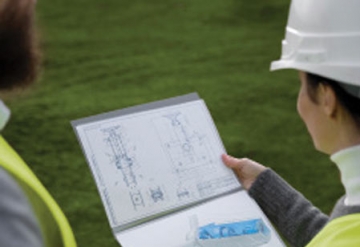THANK YOU FOR SUBSCRIBING

Three Steps To Set Your Design - Build Job Up For Success
Christine Sosnowski, Design Phase Manager, GE Johnson Construction Company

 Christine Sosnowski, Design Phase Manager, GE Johnson Construction Company
Christine Sosnowski, Design Phase Manager, GE Johnson Construction CompanyDesign-build jobs are increasingly present in the Rocky Moun[1]tain region due to their speed to market, cost management, and “master builder” advantages. As the general contrac[1]tor leads most design-build jobs, it’s imperative to have a manager setting the job up for success. These tools and tips yield the client’s (and trade partners’) trust and respect in their design-build partner and create the organization and attention to detail that your project needs to start on the right foot.
1. Facilitate a Kickoff Meeting with the Client.
First things first - setting up a meeting with key stakeholders. Oftentimes, senior leadership holds the decision[1]maker role for the project in the beginning, so this meeting should be scheduled a few weeks in advance with an agenda distributed at least 48 hours ahead of time. This allows team members to collect their thoughts and prepare appropriately.
The first part of this meeting should include a session to define conditions of satisfaction, or “What will it take to make this project successful at the project’s completion?”. It’s key to discuss not only quantitative but qualitative goals as well. What will the team culture be like? What creates trust from the client’s perspective? What breaks trust? I encourage the facilitator of this session to have all team members create specific goals. “On time” and “on budget” is generic – teams should identify measurable goals so we can all hold each other accountable for hitting these specific, measurable goals.
This meeting should also address the client’s project requirements. Ideally, these are illustrated in the request for proposal (RFP) sent by the client, but if they are not, the design-build team can help the client populate program goals, sustainability goals, and more. The agreed-upon goals are key to set and agree upon at the beginning, so changes to these aren’t surprising later.
In the spirit of transparency, discussing known risks to the best of our ability and assigning values to those risks creates trust. Clients are often turned off by a contingency percentage included in a proposal. By creating an itemized list, the design-build team shares what we think could or will go wrong, validating the overall contingency. Ultimately, this should be a live list tracked throughout the project’s life.
When the design-builder responds to an RFP, we include construction strategies such as prefabrication. In the kickoff meeting, the team should specifically define these goals. For example, what prefabrication systems will be used? What are the overall schedule, cost, quality, sustainability, and safety advantages?
Lastly, there are times when this is the client’s first design-build project. A quick refresher on the design-build process and procedures is recommended, even if they are seasoned in this delivery method. How will this team be making decisions during design? What is the cut-off point for decisions to be made schedule-wise? What happens if certain decisions change? How can we define those parameters? Who are the key decision-makers for each party?
“By creating an itemized list, the design-build team shares what we think could or will go wrong, validating the overall contingency. Ultimately, this should be a live list tracked throughout the project’s lif”
This first kickoff meeting can be 2 to 3 hours, depending on the project size and scope. We, as the design[1]builder, need to create the building blocks for the project from organization to alignment, which sets goals and expectations from the beginning.
2. Facilitate a Kickoff meeting with the Design Team and key Trade Partners.
The client and design team/trade partner kickoff meetings have different goals. The former invokes goal and expectation setting, and the latter is more detailed and defines workflow, information handoffs, and cost/schedule alignment.
First, review the same design-build processes and procedures with this team. One tool we’ve enacted in our design-build jobs is cluster groups. Borrowed from lean construction, cluster groups describe a way to batch your work into smaller, more manageable scopes.
For example, instead of having one meeting to talk about all things design, we host weekly mechanical/electrical/plumbing/ fire protection (MEPF) and have all the experts related to that topic in that meeting. One consistent party attends all meetings and informs the cross-pollination of decisions to these groups.
Once the owner project requirements (or basis of design parameters) are defined, they should be reviewed with the design team and trade partners so the right systems are designed from the start. It’s important to also share what items the client will carry and what items are excluded from the budget (for example, furniture, fixtures, and equipment/FF&E).
Schedule alignment in this kickoff does wonders. There are many times I’ve seen the design schedule, client’s master schedule and Critical Path Method Schedule (CPM) show inconsistent dates for milestones that need to be addressed right away. Likewise, the team should review overall milestones and durations and list these important dates in weekly meetings as a reminder for the next milestone.
Lastly, there should be a clear path forward in terms of tasks and key handoffs of information within the next design phase. For example, if you start schematic design in two weeks, hold a phase plan meeting with the design team and trade partners, pulling tasks back from that end milestone. As you move forward, host weekly work plan meetings to review the details, manage constraints/ roadblocks, and manage task completion.
3. Set up the tools necessary for the team to succeed.
Organization at the beginning is paramount. Since the design-builder is leading the charge, they should be the ones to instate a platform for document sharing (such as Box or Teams), set up a live document/website to share project costs (Join, for example), and set up a place for the building information modeling (BIM) model to be hosted, shared, and tracked live.
These three important steps lead to happy and successful clients, design teams, and trade partners when implemented.
Read Also
Development of the Logistics Warehousing Market in Brazil
Driving Innovation and Preserving Tradition
Operational Leadership VS Field Leadership in the Utility Construction Business
People-First Innovation: Developing Virtual Design and Construction (VDC) Training Programs to Empower Field Team Members
Sustainable Projects: Aligning Business and Purpose in Latin America
Engage Smarter: Why Constraints Matter More Than Hazards

 Copyright © 2025 All Rights Reserved | by:
Copyright © 2025 All Rights Reserved | by: Construction Tech Review
| Subscribe | About us | Sitemap| Editorial Policy| Feedback Policy














